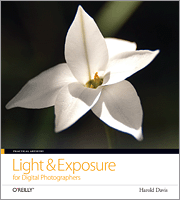|

|
This book is well illustrated with the author's own pictures, each being clearly relevant to the topic in the main text. It's easy to find a heading such as "Intentional Over and Underexposure", find a picture you like, and read about how the author took that picture, and why he made those choices. It covers the ground of shutter speed, aperture and ISO sensitivity comprehensively, highlighting the artistic benefits of each choice. It's less comprehensive on lighting, and uses quite a narrow range of images as examples.
Photography has been around for a long time, and readers might ask whether "digital" photography has changed enough to need new books. This volume covers familiar ground about apertures and shutter speeds, which is largely comparable to traditional film photography, but there are some changes, and this book does bring them out clearly. You can choose the ISO sensitivity for each image (balancing performance with noise interference), that you can see the image on the camera's LCD and learn from that to take another straight away, and that you can edit or even combine the images later in software, gaining flexibility from RAW format data.
The book studiously avoids hardware-specific issues, but does address questions like the position of your flash (front lighting is not subtle), the available range of apertures (many compact cameras have a narrow range, around f/8) and the physical size of the image sensor (smaller sensors are more vulnerable to noise, but have a greater depth of field). Where he does mention hardware, it's usually digital SLRs camera from Nikon or Canon.
This is very much about exposure. The aperture lets you control depth of field, to tell a story, direct attention, or just to have good bokeh. The shutter speed lets you avoid camera shake, freeze the subject's movement or accentuate it. The ISO sensitivity lets you improve colour quality, create artistic effects with noise, or just balance the exposure. The light meter built in to your camera will often not expose the image you really want, so spot metering and intentional exposure adjustments are well covered. Reasons for making each of the choices are discussed, particularly in terms of the artistic or story-telling effect.
Lighting is covered more briefly, with pages about flash, direction of lighting, sunlight at different times of day, white balance, and using a minimal studio. However, each of those topics is breezed over, by comparison to the exposure. At least one factor of the shutter speed goes completely un-mentioned; that at high speeds, the shutter is really a slit in a curtain moving gradually across the sensor, which could result in the same part of a fast moving subject smearing across the whole frame.
There is a section on the "digital darkroom", which wisely steers clear of being a tutorial on Adobe Photoshop. The author recommends capturing RAW files, but doesn't fully explain their strengths (they are higher resolution than JPEGs, typically being 12 bits per colour channel instead of 8, and contain exactly what was captured by the sensor and so can be reprocessed later without making things any worse than the processing done in the camera). The mathematical side seems to daunt him, in the apparent backwardness of white balance adjustments, and earlier, the relationship between aperture F-stops and the total amount of light, which is explained somewhat shakily.
The example images are clear and closely involved with the text. However, they do focus on the author's preferred topics; landscapes of mountains or bridges, flowers, and macro shots of water droplets. Almost every point in the text is illustrated, and the descriptions are really good at bringing out how the choices were made. However, there are many other styles of picture, and particularly many other issues with lighting, that are not covered.
The narrative flows well, partly because of the personal and friendly style. The print quality of the book is good, which is important, although the white space is all around the pictures and not around the body text, and unfortunately several key features of large pictures are hidden by the book spine. While the early topics of the book are covered in great detail, the later ones, (mainly about lighting) are skimmed more briefly.
In summary, the book is good on the artistic consequences of exposure in pictures of nature. It's fun to read, and really helps in making those choices an intermediate photographer might not have understood. But it's not truly comprehensive, either in its examples or in addressing its own title.
Contents 1. Understanding Exposure 2. Working with Aperture 3. Selecting Shutter Speed 4. ISO and Noise 5. Using Light 6. Digital Darkroom Index
